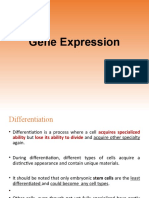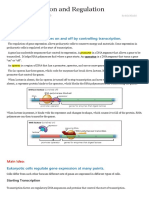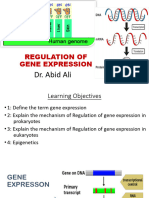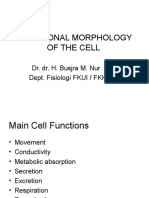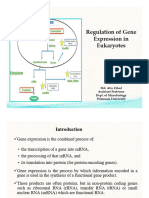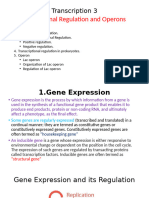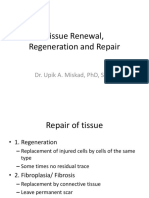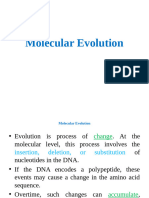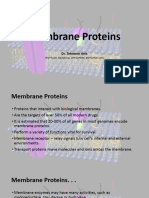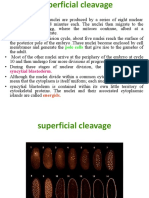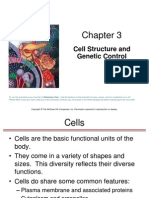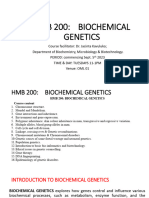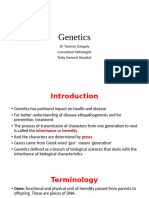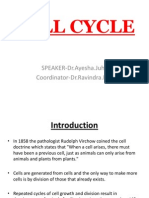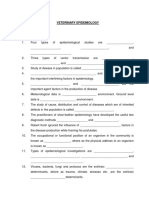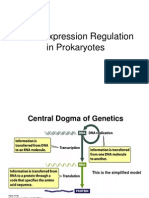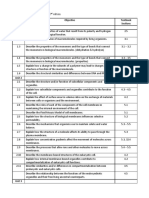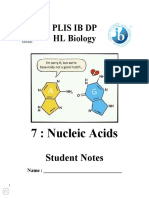0 ratings0% found this document useful (0 votes)
347 viewsOrganization of Genome in Prokaryotes and Eukaryotesppt
Organization of Genome in Prokaryotes and Eukaryotesppt
Uploaded by
Ramesh Beniwal1. Gene regulation in eukaryotes is more complex than in prokaryotes due to multicellular organisms needing specialized cell types.
2. While all cells contain the same genes, gene regulation allows each cell type to express different proteins for their specialized functions.
3. In eukaryotes, genes contain non-coding regions which are removed during mRNA processing through splicing, joining the coding regions to form a mature mRNA.
Copyright:
© All Rights Reserved
Available Formats
Download as PPT, PDF, TXT or read online from Scribd
Organization of Genome in Prokaryotes and Eukaryotesppt
Organization of Genome in Prokaryotes and Eukaryotesppt
Uploaded by
Ramesh Beniwal0 ratings0% found this document useful (0 votes)
347 views24 pages1. Gene regulation in eukaryotes is more complex than in prokaryotes due to multicellular organisms needing specialized cell types.
2. While all cells contain the same genes, gene regulation allows each cell type to express different proteins for their specialized functions.
3. In eukaryotes, genes contain non-coding regions which are removed during mRNA processing through splicing, joining the coding regions to form a mature mRNA.
Original Description:
installing serverpilot
Original Title
3. Organization of Genome in Prokaryotes and Eukaryotesppt
Copyright
© © All Rights Reserved
Available Formats
PPT, PDF, TXT or read online from Scribd
Share this document
Did you find this document useful?
Is this content inappropriate?
1. Gene regulation in eukaryotes is more complex than in prokaryotes due to multicellular organisms needing specialized cell types.
2. While all cells contain the same genes, gene regulation allows each cell type to express different proteins for their specialized functions.
3. In eukaryotes, genes contain non-coding regions which are removed during mRNA processing through splicing, joining the coding regions to form a mature mRNA.
Copyright:
© All Rights Reserved
Available Formats
Download as PPT, PDF, TXT or read online from Scribd
Download as ppt, pdf, or txt
0 ratings0% found this document useful (0 votes)
347 views24 pagesOrganization of Genome in Prokaryotes and Eukaryotesppt
Organization of Genome in Prokaryotes and Eukaryotesppt
Uploaded by
Ramesh Beniwal1. Gene regulation in eukaryotes is more complex than in prokaryotes due to multicellular organisms needing specialized cell types.
2. While all cells contain the same genes, gene regulation allows each cell type to express different proteins for their specialized functions.
3. In eukaryotes, genes contain non-coding regions which are removed during mRNA processing through splicing, joining the coding regions to form a mature mRNA.
Copyright:
© All Rights Reserved
Available Formats
Download as PPT, PDF, TXT or read online from Scribd
Download as ppt, pdf, or txt
You are on page 1of 24
ORGANIZATION OF GENOME IN
PROKARYOTES AND EUKARYOTES
The processes that enable information to be
copied from genes and then used to synthesize
proteins must be regulated if an organism is to
survive.
Different cells within an organism share the same
set of chromosomes.
In each cell some genes are active while others
are not.
For example, in humans only red blood cells
manufacture the protein hemoglobin and only
pancreas cells make the digestive enzyme known
as trypsin, even though both types of cells contain
the genes to produce both hemoglobin and
trypsin.
Each cell produces different proteins according
to its needs so that it does not waste energy by
producing proteins that will not be used.
A variety of mechanisms regulate gene activity
in cells.
One method involves turning on or off gene
transcription, sometimes by blocking the
action of RNA polymerase, an enzyme that
initiates transcription.
Gene regulation may also involve mechanisms
that slow or speed the rate of transcription,
using specialized regulatory proteins that bind
to DNA.
Depending on an organisms particular needs,
one regulatory protein may spur transcription
for a particular protein, and later, another
regulatory protein may slow or halt
transcription.
Gene Structure
Transcription proceeds from left to right, regardless of
the orientation of the gene in the chromosome.
This means that the promoter lies to the left of the
coded region.
Taking the gene DNA organization first:
Transcription starts at the transcription initiation site,
and stops when it encounters the polyA attachment site.
Transcription produces mRNA as a copy of the
DNA, from the initiation site to the polyA attachment
site.
A set of enzymes then attaches a series of a hundred
or more As to the mRNA called the polyA tail.
This tail appears to protect the mRNA from
degradation by enzymes.
So mRNA is simply a single strand of bases,
copied from the genomic DNA, from the initiation
site and ending with a polyA tail.
The start codon, for translation, is always AUG,
which encodes methionine and at the end is a stop
codon UGA.
Genes in development
Gene regulation helps individual cells within an organism
function in a specialized way.
Other regulatory mechanisms coordinate the genes that
determine how cells develop.
All of the specialized cells in an organism, including those of
the skin, muscle, bone, liver, and brain, derive from identical
copies of a single fertilized egg cell.
Each of these cells has the exact same DNA as the original
cell, even though they have vastly different appearances and
functions.
Genes dictate how these cells specialize.
Early in an organisms embryonic development the overall
body plan forms.
Individual cells commit to a particular layer and region of the
embryo, often migrating from one location to another to do so.
As the organism grows, cells become part of a particular body
organ or tissue, such as skin or muscle.
Ultimately, most cells become highly specializednot only to
develop into a neuron rather than a muscle cell,
for example, but to become a sensory neuron instead of a
motor neuron.
This process of specialization is called differentiation.
At each stage of the differentiation process, specific
genes known as developmental control genes actively
turn on and switch off the genes that differentiate
cells.
One class of developmental control genes, known as
homeotic genes, directs the formation of particular
body parts.
Activating one set of homeotic genes instructs part of
an embryo to develop into a leg, while another set
initiates the formation of the head.
If a homeotic gene becomes altered or damaged, an
organisms body development can be dramatically
disrupted.
A change in a single gene in some insects, for
instance, can cause a leg to grow where an antenna
belongs.
Homeotic genes work by regulating the activity of
other genes.
Homeotic genes code for the production of a
regulatory protein that can bind to DNA and thus
affect the transcription of one or more genes.
This enables homeotic genes to initiate or halt the
development and specialization of characteristics in
an organism
Nearly identical homeotic genes have been identified
in varied organisms, such as insects, worms, mice,
birds, and humans, where they serve similar
embryonic development functions.
Scientists view that homeotic genes first appeared in
a single ancestor common to all these organisms.
Sometime in evolutionary history, these organisms
diverged from their common ancestor, but the
homeotic genes continued to be passed down through
generations virtually unchanged during the evolution
of these new organisms.
The information present in the gene is not
always used.
Many genes remain silent and are expressed
only when the gene product is needed.
However, there are certain genes whose
products are constantly needed for cellular
activity.
These are known as housekeeping genes.
Gene Expression in Prokaryotes
An average bacterium, contains one thousands the
DNA content of a typical eukaryotic cell.
The bacterial chromosome contains a single circular
DNA molecule associated with a few proteins and is
not enclosed within a limiting membrane unlike that
in the eukaryotic cell.
Bacteria can divide very rapidly. The doubling time is
also referred to as generation time and in some
bacteria, this can be as low as 20 minutes from a
single origin of replication and can proceed
bidirectionally.
The bacterium Escherichia coli has about 2,500 genes.
The expression of these genes is usually controlled to
achieve maximum cellular economy.
This means that genes will be turned on or off as per the
requirement.
A set of genes will be switched on when there is necessity to
handle and metabolise a new substrate.
When these genes are turned on, enzymes are produced,
which metabolise the new substrate.
The phenomenon is known as induction and the small
molecules eliciting this induction are referred to as
inducers.
When a metabolite needed by the bacterium is provided in
excess from outside, the bacterium stops making it and thus
conserves its reserves.
This is achieved by the added metabolite turning off a set of
genes involved in producing that metabolite in the bacterial
cell. This phenomenon is known as feed back repression.
As against the processes of induction and repression as
already indicated a set of genes are constantly expressed to
take care of house keeping functions such as glycolysis.
These genes which are constantly expressed are referred to
as constitutive.
In 1961, Francois Jacob and Jacques Monod, at the
Pasteur Institute in Paris, proposed that metabolic path ways
are regulated as a unit.
For example, when the sugar lactose is added to the cultures
of E. coli, it induces three enzymes necessary to break down
the lactose into glucose and galactose.
Bacterial operons
Lac operon :
This operon consists of 3 genes, lac Z, Y and A coding for -
galactosidase, permease and transacetylase catalyzing a
catabolic pathway.
The genes for these three enzymes occur adjacent to each other
and thus are linked.
These are referred to as structural genes, since they have the
information to code for the amino acid sequence and thus
directly decide the structure and function of the individual
proteins of the pathway.
These 3 genes are regulated as a unit by a single switch
operator O.
This entire unit is referred to as an operon.
RNA polymerase binds to the promoters region P and
initiates transcription.
Under normal conditions transcription cannot proceed, since a
repressor protein coded by the i gene binds to the operator
and blocks RNA polymerase movement.
In the presence of the inducer lactose, the repressor protein
structure is modified such that the repressor cannot bind to the
operator any more.
This leads to the transcription of the operon and induction of
-galactosidase and the other two enzymes..
When the switch is on, the three genes are transcribed by
RNA polymerase into a single stretch of mRNA covering all
the three genes.
Each gene segment is referred to as a cistron and the long
messenger RNA covering all the cistrons is known as
polycistronic.
Gene Expression in Eukaryotes
Gene regulation in eukaryotes is more complex than in
bacteria and other prokaryotes.
Higher eukaryotes have several thousand genes.
Unlike the unicellular bacterium, these are multicellular
organisms which can also undergo differentiation.
Thus, the cells in the undifferentiated stage not only grow and
divide, but are also destined to become part of specialized
tissues such as the liver, spleen or heart in an animal and the
leaf, root, stem or flower in an angiosperm.
Thus regulation of gene expression in the eukaryotic cell is
very complex.
Most multicellular organisms contain different types
of cells that serve specialized functions.
The cells of an animals heart, blood, skin, liver, and
muscles all contain the same genes.
But in order to carry out their specific functions
within the body, each cell must produce different
proteins and respond to changing environmental
stimuli, such as glucose levels in the blood or body
temperature.
Such specialization is possible only with
sophisticated gene regulation
The information on the eukaryotic gene for assembling a
protein is not continuous, but split.
However, when messenger RNA is formed from such genes,
the unwanted RNA regions are removed and the regions
coding for amino acids are joined together. This process is
referred as SPLICING.
Bases in the messenger RNA and amino acids in proteins are
collinear even in eukaryotic cells, although the genes are split.
The regions of a gene, which become part of a mRNA and
code for different regions of the protein, are referred to as
exons.
The regions which do not form part of RNA processing before
mRNA formation are referred to as introns.
In eukaryotes, genes involved in coding for the enzymes of a
particular metabolic pathway need not to be linked.
Sometimes they are present even on different chromosomes.
However, such genes are regulated together just as in bacterial
operons.
The basic processes of induction and repression is constantly
regulated by the changing environment in the cell.
Thus during growth and development, small molecules such
as hormones, vitamins, metal ions, chemicals and invading
pathogens can induce or repress certain genes and this would
result in the production or absence of certain proteins.
Eukaryotes use a variety of mechanisms to ensure that each
cell uses the exact proteins it needs at any given moment.
In one method, eukaryotic cells use DNA sequences called
enhancers to stimulate the transcription of genes located far
away from the point on the chromosome where transcription
occurs.
If a specific protein binds to an enhancer site on the DNA, it
causes the DNA to fold so that the enhancer site is brought
closer to the site where transcription occurs.
This action can activate or speed up transcription in the
genes surrounding the enhancer site, thereby affecting the
type and quantity of proteins the cell will produce.
Enhancers often exert their effects on large groups of
related genes, such as the genes that produce the set of
proteins that form a muscle cell.
Gene regulation can also take place after transcription has
occurred by interfering with the steps that modify mRNA
before it leaves the nucleus to take part in translation.
This process typically involves removing exons (segments
that code for specific proteins) and introns.
These sections of the mRNA can be modified in more than
one way, enabling a cell to synthesize different proteins
depending on its needs.
THANK YOU
You might also like
- 11 GeneExpressionDocument31 pages11 GeneExpressionIndragee EkanayakeNo ratings yet
- Controlled Gene Expression During DevelopmentDocument38 pagesControlled Gene Expression During Developmentvampier7277788No ratings yet
- 8.6 - Gene Expression and RegulationDocument3 pages8.6 - Gene Expression and Regulationjak radeNo ratings yet
- Regulation of Gene ExpressionDocument73 pagesRegulation of Gene Expressionm.alyanhanif563No ratings yet
- Cell DifferentiationDocument25 pagesCell Differentiationwolfsamriddhi27No ratings yet
- Topic 3 Cell Differentiation and VariationDocument7 pagesTopic 3 Cell Differentiation and VariationdaniaNo ratings yet
- Cell DifferentiationDocument26 pagesCell DifferentiationQusai Haimone100% (1)
- Functional Morphology of The Cell: Dr. Dr. H. Busjra M. Nur MSC Dept. Fisiologi Fkui / FkkumjDocument74 pagesFunctional Morphology of The Cell: Dr. Dr. H. Busjra M. Nur MSC Dept. Fisiologi Fkui / FkkumjOrin OyienNo ratings yet
- bbt193003 - Yeshua ShahzadDocument9 pagesbbt193003 - Yeshua ShahzadAbuzar KhanNo ratings yet
- Control of DifferentiationDocument39 pagesControl of DifferentiationShampa SenNo ratings yet
- Chapter 07 DNA To ProteinDocument41 pagesChapter 07 DNA To ProteinalicialaayNo ratings yet
- Chapter 11 Gene ExpressionDocument17 pagesChapter 11 Gene ExpressionAllyssa Mae ClorionNo ratings yet
- 5月 6日 字 - 24 MCB1 - Ch08Document53 pages5月 6日 字 - 24 MCB1 - Ch08조주니No ratings yet
- The Operon ModelDocument44 pagesThe Operon Modelfae-ar_raziNo ratings yet
- 1 IntroductionDocument28 pages1 IntroductionWael OsmanNo ratings yet
- Regulation of Gene Expression in Eukaryotes (Light)Document46 pagesRegulation of Gene Expression in Eukaryotes (Light)Amit PaulNo ratings yet
- Transcription 3Document15 pagesTranscription 3munayam.4886No ratings yet
- Cell Biology Ch21 Part 1 05222023 강의자료Document32 pagesCell Biology Ch21 Part 1 05222023 강의자료조형윤No ratings yet
- Gene Expression Is Controlled by A Number of FeaturesDocument35 pagesGene Expression Is Controlled by A Number of FeaturesMaisarah HalimNo ratings yet
- Control of Gene ExpressionDocument34 pagesControl of Gene ExpressiongshasantopalNo ratings yet
- Tissue Renewal, Regeneration and RepairDocument41 pagesTissue Renewal, Regeneration and RepairLIEBERKHUNNo ratings yet
- Molecular EvolutionDocument39 pagesMolecular EvolutionobaiahNo ratings yet
- Gene ExpressionDocument16 pagesGene ExpressionmidhunbonumahanthiNo ratings yet
- Membrane Proteins - Signaling Molecules and Receptors v2Document67 pagesMembrane Proteins - Signaling Molecules and Receptors v2Talha KhanNo ratings yet
- Pattern Formation in DrosophilaDocument17 pagesPattern Formation in DrosophilaAdwika Deo100% (1)
- Cytogenetics, Mitosis and MeiosisDocument17 pagesCytogenetics, Mitosis and MeiosisdomeniclwandileNo ratings yet
- Lecture Intro To Cell Physiology VersionDocument57 pagesLecture Intro To Cell Physiology Versionranart8100% (1)
- 11 OperonDocument24 pages11 OperonSanghaviNo ratings yet
- Genetics DP1Document116 pagesGenetics DP1sidra.mahNo ratings yet
- Lecture 4 Cell Division Mitosis and CancerDocument74 pagesLecture 4 Cell Division Mitosis and CancerGerald AdolfoNo ratings yet
- Chapter 11 - Cell Communication Section A: An Overview of Cell SignalingDocument11 pagesChapter 11 - Cell Communication Section A: An Overview of Cell SignalingMin-Ho ChoNo ratings yet
- Biochemistry of GeneticsDocument289 pagesBiochemistry of Genetics46nv7gphxzNo ratings yet
- Microbiology Lecture 4 Microbial Genetics 2023Document82 pagesMicrobiology Lecture 4 Microbial Genetics 2023Mahelet AlamenewNo ratings yet
- Biology EOC Review ALL StandardsDocument83 pagesBiology EOC Review ALL StandardsmspallardNo ratings yet
- MCP 02.11 MitosisDocument31 pagesMCP 02.11 MitosisMohamad DarazyNo ratings yet
- Prepared By: En. Muhd Fazli B. DollahDocument11 pagesPrepared By: En. Muhd Fazli B. DollahilyNo ratings yet
- Science and TechnologyDocument97 pagesScience and TechnologyShivaniNo ratings yet
- Animal DevelopmentDocument43 pagesAnimal DevelopmentZach ThorpeNo ratings yet
- Bio 1Document6 pagesBio 1zachharveyneilNo ratings yet
- Genetics by TGDocument53 pagesGenetics by TGrubypath2017No ratings yet
- Chapter 3 - Tissue Renewal, Regeneration, and RepairDocument12 pagesChapter 3 - Tissue Renewal, Regeneration, and RepairAgnieszka WisniewskaNo ratings yet
- Cell OrganallesDocument49 pagesCell Organallesbasi36941No ratings yet
- Epigenetics and Chromatin RemodellingDocument30 pagesEpigenetics and Chromatin RemodellingMaxine RibeiroNo ratings yet
- The Cell 1Document66 pagesThe Cell 1Patricia JalbanNo ratings yet
- Chapter 3-Cell Structure and TaxonomyDocument60 pagesChapter 3-Cell Structure and TaxonomyMarcos AlbaridaNo ratings yet
- Animal Development: Cell Biology October 23, 2013Document16 pagesAnimal Development: Cell Biology October 23, 2013RustEdNo ratings yet
- Gene Expression and Regulation - Mutation PDFDocument57 pagesGene Expression and Regulation - Mutation PDFEsther MathengeNo ratings yet
- GeneticDocument8 pagesGeneticnooramubarakkNo ratings yet
- Genome Size & Organization, & Gene Regulation in ProkaryotesDocument21 pagesGenome Size & Organization, & Gene Regulation in ProkaryotesGayathri deviNo ratings yet
- Cell Cycle: SPEAKER-Dr - Ayesha.Juhi Coordinator-Dr - Ravindra.P.NDocument38 pagesCell Cycle: SPEAKER-Dr - Ayesha.Juhi Coordinator-Dr - Ravindra.P.NAyesha SKNo ratings yet
- Stem Cell Therapy Hope or HypeDocument45 pagesStem Cell Therapy Hope or HypeSiddharth DhanarajNo ratings yet
- RegGenExp (Khusus Palangkaraya 2011), Bahan Ujian SajaDocument20 pagesRegGenExp (Khusus Palangkaraya 2011), Bahan Ujian SajaeciNo ratings yet
- Introduction To Prokaryotic GenomeDocument36 pagesIntroduction To Prokaryotic Genomelovehenna31No ratings yet
- General Biology 2Document13 pagesGeneral Biology 2Iren Castor MabutinNo ratings yet
- Cell Biology-Unit 1Document13 pagesCell Biology-Unit 1Kazo SaŋNo ratings yet
- Cell Bio Learning GuideDocument50 pagesCell Bio Learning GuideMichaela DereloNo ratings yet
- Control of Gene ExpressionDocument5 pagesControl of Gene ExpressionAllysa Mae PedeNo ratings yet
- The Basics of Cell Life with Max Axiom, Super Scientist: 4D An Augmented Reading Science ExperienceFrom EverandThe Basics of Cell Life with Max Axiom, Super Scientist: 4D An Augmented Reading Science ExperienceNo ratings yet
- 164development and EvaluationDocument6 pages164development and EvaluationRamesh BeniwalNo ratings yet
- 911200711841PM Frozen - SemenDocument1 page911200711841PM Frozen - SemenRamesh BeniwalNo ratings yet
- 911200710127PM Consent - FormDocument1 page911200710127PM Consent - FormRamesh BeniwalNo ratings yet
- Jktlfkku LJDKJ Ik'Kq Ikyu Fohkkx VKMV MKSJ JFTLVJDocument1 pageJktlfkku LJDKJ Ik'Kq Ikyu Fohkkx VKMV MKSJ JFTLVJRamesh BeniwalNo ratings yet
- Scheduled Diseases Under Section 2 (O) and 38 of The Prevention and Control of Infectious and Contagious Diseases in Animals Act, 2009Document1 pageScheduled Diseases Under Section 2 (O) and 38 of The Prevention and Control of Infectious and Contagious Diseases in Animals Act, 2009Ramesh BeniwalNo ratings yet
- 9112007125312PM Form1Document3 pages9112007125312PM Form1Ramesh BeniwalNo ratings yet
- Ethanovet2 1 PDFDocument1 pageEthanovet2 1 PDFRamesh BeniwalNo ratings yet
- Syllabus-VPE-321 Veterinary Epidemiology and ZoonosesDocument1 pageSyllabus-VPE-321 Veterinary Epidemiology and ZoonosesRamesh BeniwalNo ratings yet
- 911200710053PM Blood Examination ReportDocument1 page911200710053PM Blood Examination ReportRamesh BeniwalNo ratings yet
- Question Bank ZoonosisDocument32 pagesQuestion Bank ZoonosisRamesh BeniwalNo ratings yet
- 2010 - BAAH 218D - Veterinary Parasitology Apr 2010Document7 pages2010 - BAAH 218D - Veterinary Parasitology Apr 2010Ramesh BeniwalNo ratings yet
- Question Bank EpidemiologyDocument32 pagesQuestion Bank EpidemiologyRamesh Beniwal90% (10)
- VMD 421 SyllabusDocument1 pageVMD 421 SyllabusRamesh BeniwalNo ratings yet
- VPA 221 Veterinary Entomology and AcarologyDocument9 pagesVPA 221 Veterinary Entomology and AcarologyRamesh Beniwal100% (1)
- VPA 221 Veterinary Entomology and Acarology: Red Mite of Poultry Pigeon, Cage Birds, Wild Birds Etc, Also ManDocument4 pagesVPA 221 Veterinary Entomology and Acarology: Red Mite of Poultry Pigeon, Cage Birds, Wild Birds Etc, Also ManRamesh BeniwalNo ratings yet
- Antibacterial Therapy of MastitisDocument10 pagesAntibacterial Therapy of MastitisSunil100% (2)
- VPA 221 Veterinary Entomology and Acarology: PsoroptidaeDocument7 pagesVPA 221 Veterinary Entomology and Acarology: PsoroptidaeRamesh BeniwalNo ratings yet
- VPA 221 Veterinary Entomology and Acarology: FamilyDocument13 pagesVPA 221 Veterinary Entomology and Acarology: FamilyRamesh BeniwalNo ratings yet
- WastewaterDocument32 pagesWastewaterRamesh BeniwalNo ratings yet
- Lecture 7 - Regulation of Gene Expression 05-22-12-1Document25 pagesLecture 7 - Regulation of Gene Expression 05-22-12-1Lisa Brett HoffmanNo ratings yet
- Prokaryotic and EukaryoticDocument6 pagesProkaryotic and EukaryoticHan Xin Yuun0% (1)
- ISSRF - Newsletter - 15th Ed Sept 2014Document56 pagesISSRF - Newsletter - 15th Ed Sept 2014mikeadrianNo ratings yet
- 2A GeneticsDocument47 pages2A GeneticsYashNo ratings yet
- Aspb 2012 - 106Document204 pagesAspb 2012 - 106arunprabhu_dhanapalNo ratings yet
- BIO2134 Final Exam 2011: This Part of The Exam Includes 40 Multiple Choice Questions (1 Pts/each)Document11 pagesBIO2134 Final Exam 2011: This Part of The Exam Includes 40 Multiple Choice Questions (1 Pts/each)angela100% (1)
- Zoology NEP 2021Document44 pagesZoology NEP 2021devmohitsharma6No ratings yet
- 2 - CED Reading Alignment Biology in Focus 2nd Edition 2EDocument5 pages2 - CED Reading Alignment Biology in Focus 2nd Edition 2EDani HussainNo ratings yet
- Topic 7 Nucleic Acids IBDP HL NotesDocument27 pagesTopic 7 Nucleic Acids IBDP HL NotesKathryn BrandwoodNo ratings yet
- Bio 30 2nd Long TestDocument5 pagesBio 30 2nd Long TestAira GamboaNo ratings yet
- Where Can Buy Igenetics A Molecular Approach 3ed. Edition Russell P.J. Ebook With Cheap PriceDocument64 pagesWhere Can Buy Igenetics A Molecular Approach 3ed. Edition Russell P.J. Ebook With Cheap Pricejunasesene100% (3)
- Is 2011 Book For Web Low-ResDocument294 pagesIs 2011 Book For Web Low-ResajaygradNo ratings yet
- LS-CBB-5530 Cellular and Molecular Biology Gogol Exam 2 Nov. 4, 2014Document8 pagesLS-CBB-5530 Cellular and Molecular Biology Gogol Exam 2 Nov. 4, 2014goutham278No ratings yet
- EPZ015666, A SAM-cooperative Selective Inhibitor of PRMT5 With in Vivo and in Vitro Potency in MCL ModelsDocument10 pagesEPZ015666, A SAM-cooperative Selective Inhibitor of PRMT5 With in Vivo and in Vitro Potency in MCL ModelsMatthew FengNo ratings yet
- Sharma Et Al-2016-Journal of Applied MicrobiologyDocument11 pagesSharma Et Al-2016-Journal of Applied MicrobiologyJoanaNo ratings yet
- University of Delhi: Scheme of Examination AND Course of Reading FOR B.Sc. (Hons.) BiochemistryDocument39 pagesUniversity of Delhi: Scheme of Examination AND Course of Reading FOR B.Sc. (Hons.) Biochemistryneal198No ratings yet
- Chromatin RemodellingDocument234 pagesChromatin RemodellingBetsabé Vega AbadNo ratings yet
- Epigenetics Term PaperDocument8 pagesEpigenetics Term PaperafmzrvaxhdzxjsNo ratings yet
- Stickleback GeneSwitches StudentDocument10 pagesStickleback GeneSwitches StudentHelp Me Study TutoringNo ratings yet
- Describe Gene Regulation in ProkaryotesDocument5 pagesDescribe Gene Regulation in ProkaryotesAria FinNo ratings yet
- Regulation of Gene Expression 2018Document34 pagesRegulation of Gene Expression 2018nikkiNo ratings yet
- Chapter 6Document69 pagesChapter 6علوم طبية AUG 2020No ratings yet
- Human EpigenomicsDocument234 pagesHuman EpigenomicsHeron HilárioNo ratings yet
- MCQ in BioDocument7 pagesMCQ in BioGiovanni Roccaforte100% (1)
- Biochemistry - A Short CourseDocument1,026 pagesBiochemistry - A Short CourseFelicita Urzi100% (3)
- Download ebooks file Gene Control second edition David S. Latchman all chaptersDocument81 pagesDownload ebooks file Gene Control second edition David S. Latchman all chaptersdiellybellus100% (1)
- Jichi Medical Research Overview 2015Document115 pagesJichi Medical Research Overview 2015Tenri AshariNo ratings yet
- Final Examination Bio 112-Molecular Biology and GeneticsDocument15 pagesFinal Examination Bio 112-Molecular Biology and GeneticsPrince-SimonJohnMwanza100% (1)
- Regulation of Gene Expression in Prokaryotic and Eukaryotic CellsDocument13 pagesRegulation of Gene Expression in Prokaryotic and Eukaryotic CellsMifta KhuljannahNo ratings yet
- Agriculture ChemistryDocument53 pagesAgriculture ChemistryhamidjoyiaNo ratings yet
